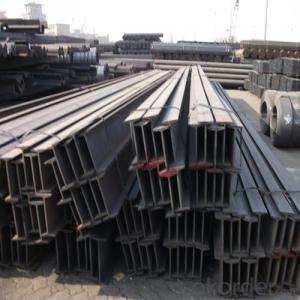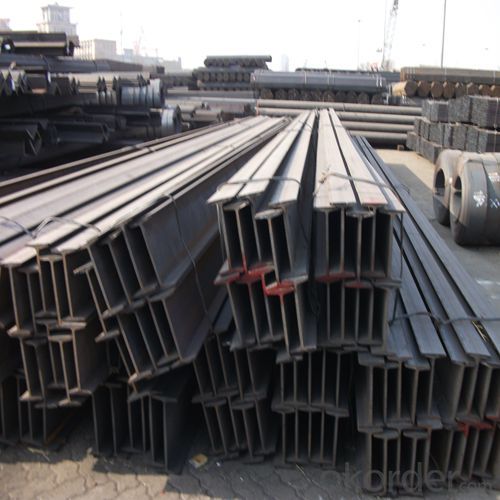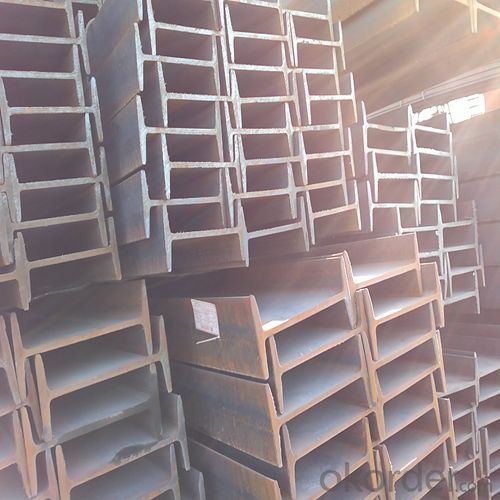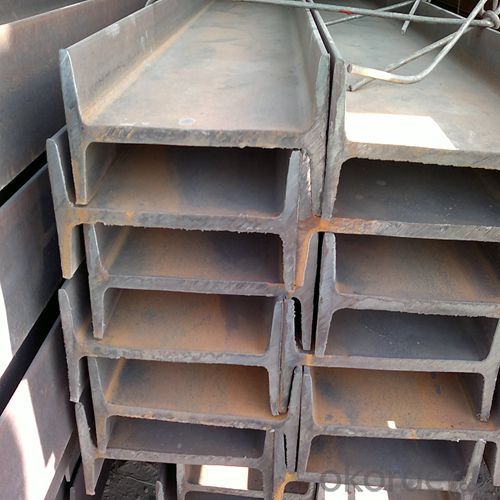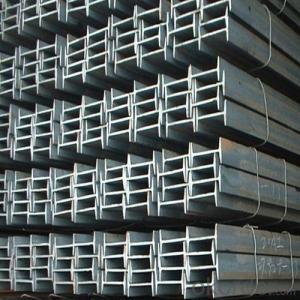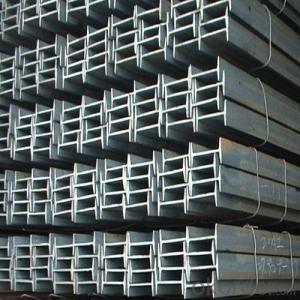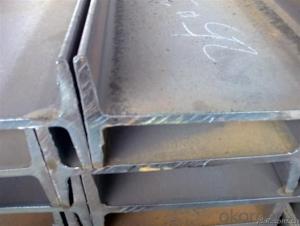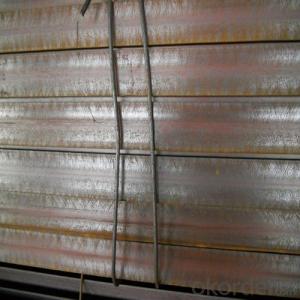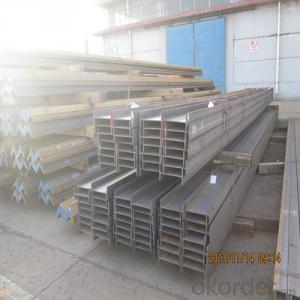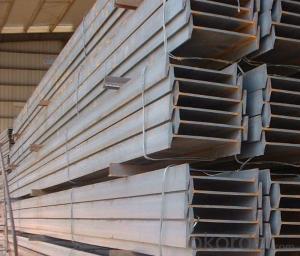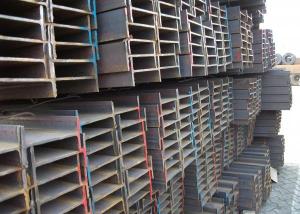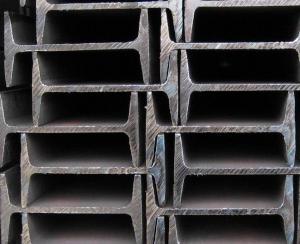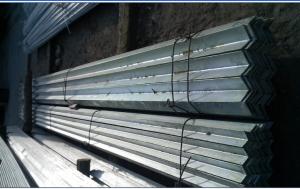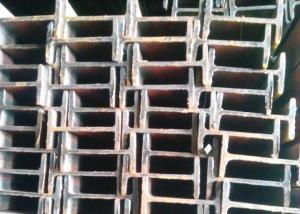Hot Rolled I-Beam Structure Steel Q235 High Quality
- Loading Port:
- Tianjin
- Payment Terms:
- TT or LC
- Min Order Qty:
- 50 m.t.
- Supply Capability:
- 40000 m.t./month
OKorder Service Pledge
OKorder Financial Service
You Might Also Like
Product Description:
OKorder is offering Hot Rolled I-Beam Structure Steel Q235 High Quality at great prices with worldwide shipping. Our supplier is a world-class manufacturer of steel, with our products utilized the world over. OKorder annually supplies products to European, North American and Asian markets. We provide quotations within 24 hours of receiving an inquiry and guarantee competitive prices.
Product Applications:
Hot Rolled I-Beam Structure Steel Q235 High Quality Hot Rolled Steel I-Beams are ideal for structural applications and are widely used in the construction of buildings and bridges, and the manufacturing, petrochemical, and transportation industries.
Product Advantages:
OKorder's Hot Rolled I-Beam Structure Steel Q235 High Quality are durable, strong, and resist corrosion.
Main Product Features:
· Premium quality
· Prompt delivery & seaworthy packing (30 days after receiving deposit)
· Corrosion resistance
· Can be recycled and reused
· Mill test certification
· Professional Service
· Competitive pricing
Product Specifications:
Usage & Applications of Hot Rolled Steel H-beam For Sale
Commercial building structure ;Pre-engineered buildings; Machinery support structure; Prefabricated structure; Medium scale bridges; Ship-building structure.etc.
Packaging & Delivery of Hot Rolled Steel H-beam For Sale
1. Packing: it is nude packed in bundles by steel wire rod
2. Bundle weight: not more than 3.5MT for bulk vessel; less than 3 MT for container load
3. Marks:
Color marking: There will be color marking on both end of the bundle for the cargo delivered by bulk vessel. That makes it easily to distinguish at the destination port.
Tag mark: there will be tag mark tied up on the bundles. The information usually including supplier logo and name, product name, made in China, shipping marks and other information request by the customer.
If loading by container the marking is not needed, but we will prepare it as customer request.
4. Transportation: the goods are delivered by truck from mill to loading port, the maximum quantity can be loaded is around 40MTs by each truck. If the order quantity cannot reach the full truck loaded, the transportation cost per ton will be little higher than full load.
5. Delivered by container or bulk vessel
FAQ:
Q1: Why buy Materials & Equipment from OKorder.com?
A1: All products offered byOKorder.com are carefully selected from China's most reliable manufacturing enterprises. Through its ISO certifications, OKorder.com adheres to the highest standards and a commitment to supply chain safety and customer satisfaction.
Q2: How do we guarantee the quality of our products?
A2: We have established an advanced quality management system which conducts strict quality tests at every step, from raw materials to the final product. At the same time, we provide extensive follow-up service assurances as required.
Q3: How soon can we receive the product after purchase?
A3: Within three days of placing an order, we will begin production. The specific shipping date is dependent upon international and government factors, but is typically 7 to 10 workdays.
Q4: What makes stainless steel stainless?
A4: Stainless steel must contain at least 10.5 % chromium. It is this element that reacts with the oxygen in the air to form a complex chrome-oxide surface layer that is invisible but strong enough to prevent further oxygen from "staining" (rusting) the surface. Higher levels of chromium and the addition of other alloying elements such as nickel and molybdenum enhance this surface layer and improve the corrosion resistance of the stainless material.
Q5: Can stainless steel rust?
A5: Stainless does not "rust" as you think of regular steel rusting with a red oxide on the surface that flakes off. If you see red rust it is probably due to some iron particles that have contaminated the surface of the stainless steel and it is these iron particles that are rusting. Look at the source of the rusting and see if you can remove it from the surface.
Images:
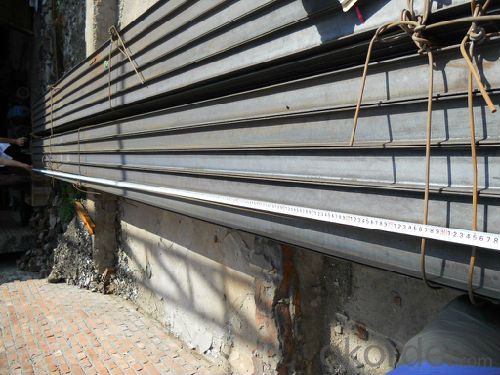
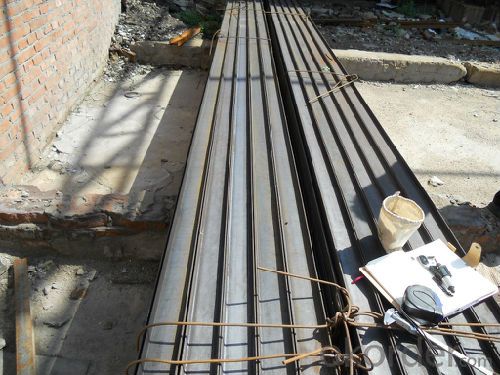
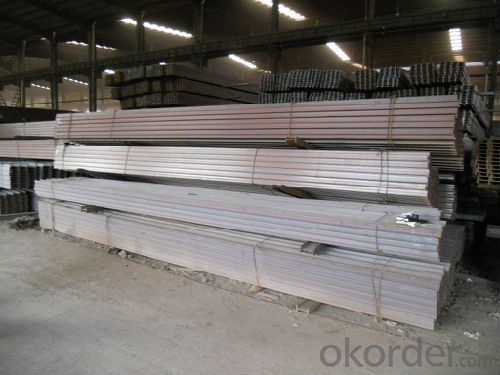
- Q: Can steel I-beams be used for cryogenic applications?
- Yes, steel I-beams can be used for cryogenic applications. Steel is known for its excellent strength and durability, making it a suitable material for various industrial applications, including cryogenic environments. However, it is important to note that the specific type of steel used must be selected carefully to ensure it can withstand the extreme temperatures and potential brittle fracture that can occur in cryogenic conditions. Additionally, proper insulation and design considerations should be taken into account to minimize heat transfer and prevent thermal stress on the steel beams.
- Q: The difference between I-beam and H steel is that a steel structure platform for cast iron machine should be designed. Cast iron captain 30 meters, every two meters with an upright column, which steel to choose?
- The difference between I-beam and H steel is that a steel structure platform for cast iron machine should be designed. Cast iron captain 30 meters, every two meters with an upright column, which steel to choose?The web is much higher than the flange and is mainly used for bending.H steel: Web and flange are highly close. Used for bending members.The column is preferentially made of section h steel.
- Q: How are steel I-beams protected against vandalism?
- There are several ways to protect steel I-beams from vandalism. One way is to apply an anti-graffiti coating to the beams, which acts as a barrier against paint, markers, and other graffiti materials. This coating makes it easier to remove any graffiti without harming the steel underneath. Another method of protection is the installation of security cameras or surveillance systems in the areas where the I-beams are located. These cameras can discourage potential vandals and provide evidence in case any vandalism occurs. Additionally, well-lit areas can deter vandalism by increasing the chances of getting caught. In certain situations, physical barriers like fences or barriers can be put up around the steel I-beams to limit access and prevent unauthorized individuals from approaching or tampering with them. This approach is especially effective in outdoor installations or public spaces. Moreover, regular maintenance and inspections are essential for identifying and addressing signs of vandalism. Timely repairs or repainting can minimize the impact of vandalism and prevent further damage. In conclusion, a combination of preventative measures, surveillance systems, regular maintenance, and prompt repairs can effectively safeguard steel I-beams against vandalism and reduce any potential harm caused by such acts.
- Q: Can steel I-beams be painted or coated to match the desired aesthetics?
- Indeed, steel I-beams have the capability to be painted or coated in order to achieve the desired aesthetics. In the realms of construction and industrial applications, steel I-beams are frequently utilized due to their indispensable strength and ability to bear heavy loads. However, the raw steel finish may not always be visually pleasing or suitable for every environment. To achieve the desired aesthetics, there are various methods available for painting or coating steel I-beams. Before commencing with the painting or coating process, it is imperative to properly prepare the surface of the beams to ensure optimal adhesion and durability. This typically involves eliminating any rust, dirt, or contaminants and applying an appropriate primer. Once the surface has been adequately prepared, a diverse range of paint or coating systems can be utilized. Industrial-grade paints, such as epoxy or polyurethane coatings, offer exceptional protection against corrosion and wear. These coatings can also be customized to attain the desired color and finish. Furthermore, powder coating is a widely favored technique for enhancing the aesthetics of steel I-beams. Powder coating involves the application of a dry powder onto the surface of the beams, which is then cured under heat to create a durable and visually appealing finish. Powder coating offers an extensive array of color options and ensures a smooth, uniform appearance. It is crucial to consider the specific requirements of the application when selecting the appropriate paint or coating system. Factors such as environmental conditions, exposure to chemicals or moisture, and the desired level of durability must be taken into account. Seeking guidance from a professional painter or coating specialist can guarantee the best outcome in terms of both aesthetics and performance.
- Q: What does plain cold pressing hot steel mean?
- The hot metal from the torpedo car can be poured into the converter as the main burden after being treated by desulphurization and slag disposal, etc., with the addition of scrap steel below 10%. Then, burning into the converter oxygen blowing, excess carbon in molten iron by oxidation and release large amounts of heat, when the probe is measured to reach a predetermined low carbon content, namely stop blowing and tapping. In general, the ladle needs to be deoxidized and adjusted to operate the ingredients. Then, the carbonized rice hull is cast on the surface of the liquid steel to prevent the molten steel from being oxidized and sent to the continuous casting or die casting work area. For high requirement steel, increasing bottom blowing argon, RH vacuum treatment, spraying powder treatment (spraying SI - CA powder and denatured lime) can effectively reduce gas and inclusion in steel, and further reduce carbon and reduce sulfur. After these measures are refined, the ingredients can be adjusted to meet the demand of high quality steel.
- Q: How do steel I-beams resist bending and deflection?
- Steel I-beams resist bending and deflection due to their unique structural design and material properties. Firstly, the shape of an I-beam plays a crucial role in its resistance to bending. The top and bottom flanges of the I-beam are wider and stiffer than the vertical web connecting them. This design creates a larger moment of inertia, which is a measure of an object's ability to resist bending. The larger moment of inertia allows the I-beam to distribute the load applied to it across a greater area, reducing the stress on any individual section. Additionally, the material properties of steel contribute to the I-beam's ability to resist bending. Steel is an exceptionally strong and rigid material, capable of withstanding high loads without significant deformation. Its high tensile strength, combined with the shape of the I-beam, allows it to efficiently transfer and distribute the applied load along its length, minimizing deflection. Moreover, the process of manufacturing steel I-beams involves hot rolling, which further enhances their strength and rigidity. During hot rolling, the steel is heated to a high temperature and then passed through a series of rollers to shape it into the desired I-beam profile. This process aligns the steel's grain structure, creating a stronger and more uniform material with improved resistance to bending and deflection. In summary, steel I-beams resist bending and deflection through a combination of their structural design and material properties. The shape of the I-beam, with wider and stiffer flanges, increases the moment of inertia and allows for the distribution of load over a larger area. The high tensile strength and rigidity of steel, as well as the hot rolling manufacturing process, further contribute to the I-beam's ability to withstand bending forces.
- Q: Can steel I-beams be used for healthcare facilities?
- Yes, steel I-beams can be used for healthcare facilities. Steel I-beams are commonly used in construction for their strength and durability, making them suitable for a variety of applications including healthcare facilities. These beams provide structural support and can be used for framing walls, floors, and roofs, ensuring the stability and integrity of the building. Additionally, steel I-beams are fire-resistant, which is crucial for healthcare facilities where safety is of utmost importance. Furthermore, steel is a sustainable and recyclable material, aligning with the growing green building practices in the healthcare industry. Overall, steel I-beams are a reliable and practical choice for constructing healthcare facilities.
- Q: How are steel I-beams fire-rated?
- To enhance their ability to withstand fire and ensure the safety of occupants, steel I-beams can be fire-rated through different methods. One approach is the application of a fire-resistant coating or paint, designed to withstand high temperatures and prevent the steel from reaching critical levels that could lead to structural failure. These coatings act as insulating barriers, slowing down heat transfer and prolonging the beams' integrity during a fire. Two types of coatings commonly used are intumescent, which expand and form an insulating layer when exposed to high temperatures, and cementitious, which provide a fire-resistant barrier. Alternatively, steel I-beams can be encased in fire-resistant materials like concrete or gypsum board. This is typically done during construction to create fire-rated floor and wall assemblies. By enclosing the beams within these materials, a protective barrier is formed, shielding the steel from the fire's heat and enhancing its fire resistance. The fire rating of steel I-beams is determined by factors such as the thickness and type of fire-resistant coating, the insulation properties of the coating, the duration for which the beams can withstand fire, and the type of fire test they have undergone. Testing laboratories, such as UL or ASTM, typically certify fire-rated steel I-beams according to recognized standards. It is important to understand that fire rating does not make steel I-beams completely fireproof. It only provides a certain level of fire resistance for a specific duration. Therefore, it is crucial to adhere to building codes and regulations and regularly inspect and maintain fire-rated steel I-beams to ensure their effectiveness in fire scenarios.
- Q: How do steel I-beams contribute to the overall energy efficiency of a structure?
- Several factors contribute to the overall energy efficiency of a structure when using steel I-beams. Firstly, the durability and long lifespan of steel make it an ideal material for construction. This means that buildings constructed with steel I-beams require less maintenance and repairs over time, resulting in reduced energy consumption and costs associated with upkeep and renovations. In addition, steel I-beams have excellent load-bearing capabilities, allowing for larger spans and open floor plans. This means that fewer beams are needed to support the structure, resulting in reduced material usage and lower energy requirements during manufacturing and transportation. Moreover, steel is highly recyclable, and at the end of their lifespan, steel I-beams can be easily repurposed or recycled. Recycling steel requires significantly less energy compared to producing new steel, resulting in reduced energy consumption and greenhouse gas emissions. Furthermore, steel I-beams are often used in combination with other energy-efficient building components, such as insulated panels or double-glazed windows. This integration improves the overall thermal performance of the structure by reducing heat transfer, minimizing energy losses, and enhancing insulation. Lastly, steel I-beams can be designed to accommodate various energy-efficient systems, such as solar panels or geothermal heat pumps. These systems can be seamlessly integrated into the structure, further reducing energy consumption by providing renewable energy sources or utilizing the earth's natural heat. In conclusion, by incorporating steel I-beams into the design and construction of a building, energy consumption, costs, and environmental impact can be significantly reduced. The durability, load-bearing capabilities, recyclability, compatibility with energy-efficient components, and ability to accommodate sustainable technologies make steel I-beams an excellent choice for enhancing the energy efficiency of structures.
- Q: Can steel I-beams be used in the construction of convention centers?
- Certainly, convention centers can employ steel I-beams in their construction. The utilization of steel I-beams is widespread in the field of construction owing to their remarkable strength, durability, and adaptability. These beams offer exceptional support and load-bearing capacities, rendering them superb for erecting extensive edifices such as convention centers. They can be employed for framing, supports, and columns, thereby contributing to the establishment of a resilient and secure structure. Moreover, steel constitutes a sustainable and eco-friendly material, thereby increasing its popularity in contemporary construction endeavors.
Send your message to us
Hot Rolled I-Beam Structure Steel Q235 High Quality
- Loading Port:
- Tianjin
- Payment Terms:
- TT or LC
- Min Order Qty:
- 50 m.t.
- Supply Capability:
- 40000 m.t./month
OKorder Service Pledge
OKorder Financial Service
Similar products
Hot products
Hot Searches
Related keywords
